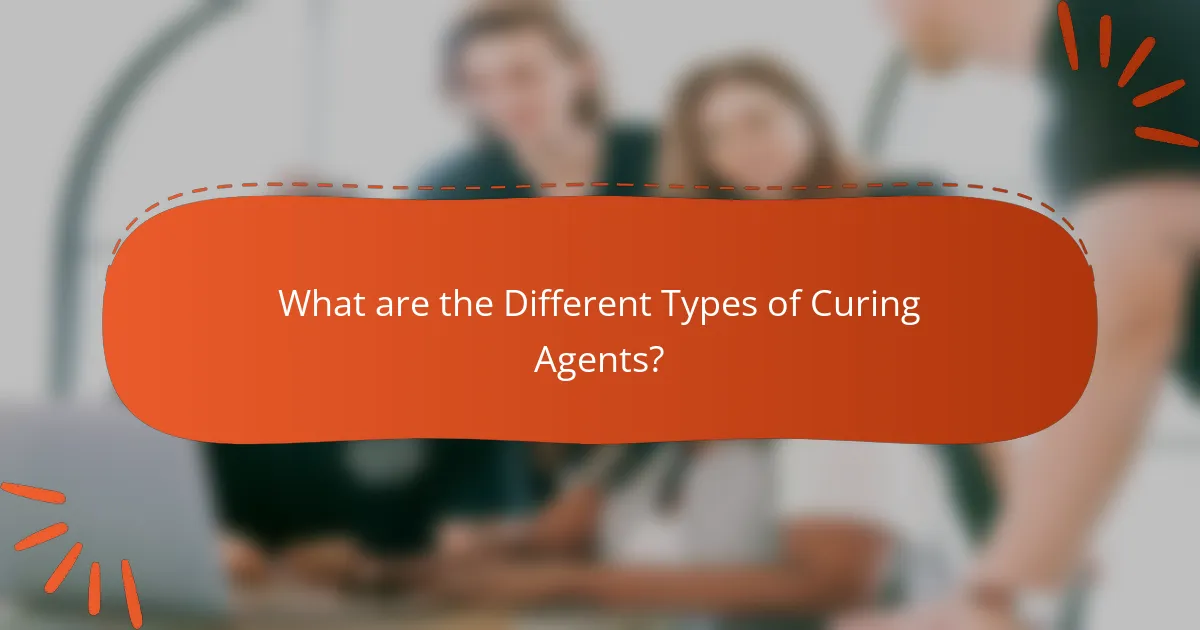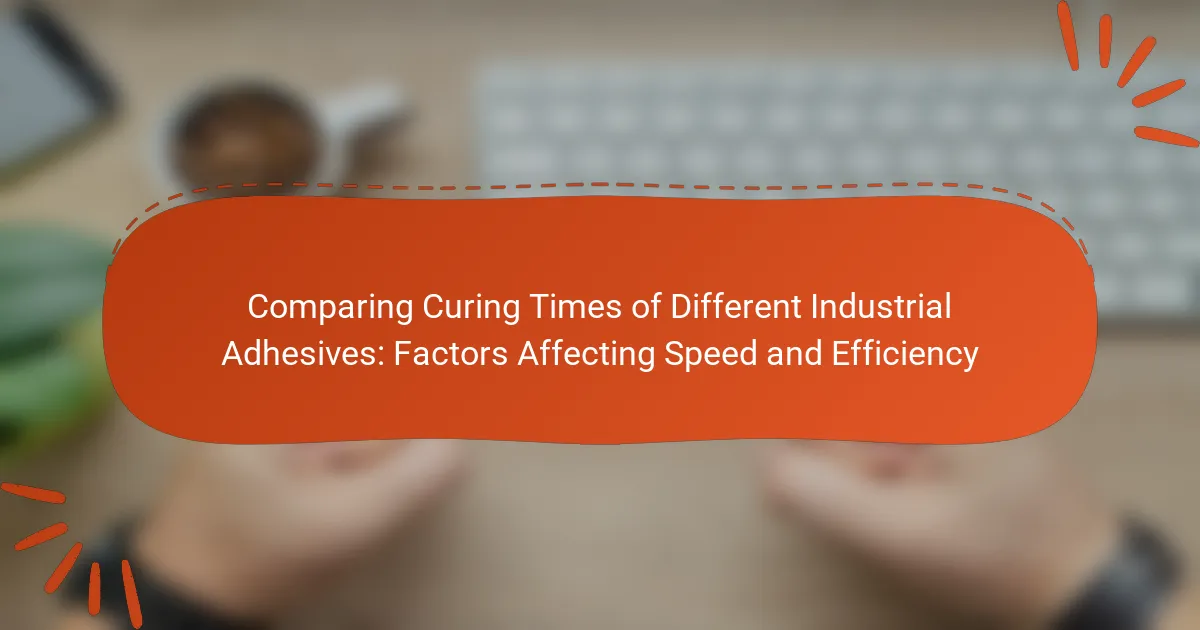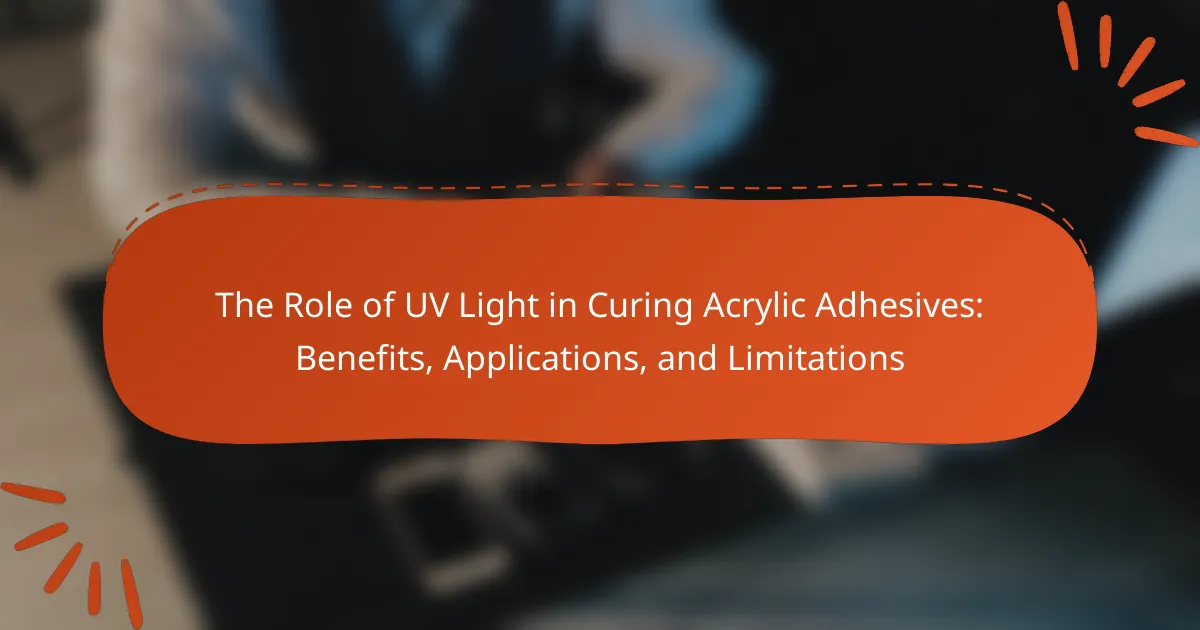Curing agents are essential substances in industrial adhesives that facilitate the hardening process through chemical reactions. This article explores the various types of curing agents, including amines, anhydrides, and polyisocyanates, highlighting their specific functions and applications. It details how these agents impact the final properties of adhesives, such as strength, durability, and flexibility. Additionally, the article discusses critical selection criteria for curing agents, including chemical compatibility, curing temperature range, and mechanical properties, ensuring optimal performance in diverse industrial applications. Understanding these elements is crucial for achieving desired adhesive characteristics and compliance with environmental regulations.

What are Curing Agents in Industrial Adhesives?
Curing agents in industrial adhesives are substances that promote the hardening process of adhesives. They react chemically with the adhesive components to initiate curing. This process transforms the adhesive from a liquid to a solid state. Common curing agents include amines, anhydrides, and polyisocyanates. Each type of curing agent serves a specific function in the curing process. For instance, amines often accelerate curing at room temperature. The choice of curing agent affects the adhesive’s final properties, such as strength and durability. Curing agents are essential for achieving the desired performance in various industrial applications.
How do Curing Agents function within Adhesives?
Curing agents function as catalysts in adhesives, facilitating the hardening process. They initiate chemical reactions that transform liquid adhesives into solid bonds. This process is essential for achieving the desired strength and durability of the adhesive. Common curing agents include amines, anhydrides, and isocyanates. Each type interacts differently with the adhesive components. For example, amines promote cross-linking in epoxy adhesives. This cross-linking enhances the adhesive’s mechanical properties. The effectiveness of curing agents depends on factors like temperature and humidity. Proper selection of curing agents is crucial for optimal adhesive performance.
What chemical processes are involved in curing?
Curing involves several chemical processes, primarily polymerization, cross-linking, and evaporation. Polymerization is the process where monomers chemically bond to form polymers, increasing molecular weight and creating a solid structure. Cross-linking refers to the formation of chemical bonds between polymer chains, enhancing mechanical strength and thermal stability. Evaporation occurs when solvents or volatile components are removed during curing, leading to a hardened material. These processes are essential in achieving the desired properties in industrial adhesives. For instance, epoxy adhesives undergo both polymerization and cross-linking to achieve optimal performance.
How do curing agents affect the adhesive’s properties?
Curing agents significantly influence the properties of adhesives. They initiate the chemical reaction that transforms adhesives from a liquid to a solid state. This transformation enhances the adhesive’s strength and durability. Curing agents can also affect the adhesion quality and resistance to environmental factors. For example, epoxy curing agents improve thermal stability and chemical resistance. In contrast, polyurethane curing agents enhance flexibility and impact resistance. The selection of a specific curing agent determines the final performance characteristics of the adhesive. Therefore, understanding the role of curing agents is essential for optimizing adhesive formulations.
Why are Curing Agents essential in Industrial Adhesives?
Curing agents are essential in industrial adhesives because they facilitate the chemical reaction that transforms adhesives from a liquid to a solid state. This transformation is crucial for achieving the desired bond strength and durability. Curing agents initiate cross-linking between adhesive molecules, which enhances the mechanical properties of the adhesive. The use of curing agents ensures that adhesives can withstand environmental factors such as temperature, humidity, and chemical exposure. For instance, epoxy adhesives require curing agents to achieve optimal performance, resulting in bonds that can withstand high stress. Without curing agents, many adhesives would remain tacky and ineffective, failing to provide reliable adhesion.
What role do they play in the performance of adhesives?
Curing agents play a crucial role in the performance of adhesives. They initiate and accelerate the curing process, transforming adhesives from a liquid state to a solid bond. This transformation enhances the adhesive’s strength, durability, and resistance to environmental factors. Curing agents also determine the adhesive’s final properties, such as flexibility and thermal stability. For instance, epoxy adhesives often require specific curing agents to achieve optimal performance. The right curing agent can significantly improve adhesion to various substrates. Therefore, selecting an appropriate curing agent is essential for achieving desired adhesive performance.
How do curing agents influence the durability of the bond?
Curing agents significantly enhance the durability of adhesive bonds. They facilitate chemical reactions that lead to the hardening of adhesives. This process improves the mechanical properties of the bond. Stronger bonds resist environmental factors such as moisture and temperature fluctuations. Curing agents can also increase resistance to chemical exposure. The choice of curing agent affects the bond’s final strength and longevity. For instance, epoxy curing agents typically yield more durable bonds than polyurethane counterparts. Studies show that properly selected curing agents can double the lifespan of adhesive applications.

What are the Different Types of Curing Agents?
Curing agents are substances that facilitate the hardening of adhesives through chemical reactions. There are several types of curing agents used in industrial adhesives. Common categories include amine-based curing agents, anhydride curing agents, and polyamide curing agents.
Amine-based curing agents react with epoxy resins to create a cross-linked structure. They are known for their fast curing times and high adhesion properties. Anhydride curing agents provide excellent thermal and chemical resistance. They are often used in applications requiring durability. Polyamide curing agents are derived from fatty acids and are known for their flexibility and toughness.
Each type of curing agent has specific applications based on its properties. The choice depends on the desired characteristics of the final adhesive product.
What are the primary categories of curing agents?
The primary categories of curing agents are amines, anhydrides, and polyisocyanates. Amines are commonly used in epoxy systems and promote cross-linking. Anhydrides are often utilized in thermosetting resins and enhance thermal resistance. Polyisocyanates are primarily used in polyurethane systems and provide flexibility and durability. Each category serves distinct roles in the curing process, contributing to the final properties of the adhesive.
How do reactive and non-reactive curing agents differ?
Reactive curing agents chemically interact with the resin to form a cross-linked structure. This reaction typically occurs during the curing process, resulting in a hardened material. Non-reactive curing agents, on the other hand, do not chemically bond with the resin. Instead, they facilitate the curing process through physical means, such as evaporation or heat application. Reactive agents often lead to stronger and more durable bonds due to the chemical cross-linking. Non-reactive agents may result in less robust materials, as they do not contribute to the molecular structure. The choice between these agents depends on the desired properties of the final product.
What are the advantages of using each type?
Curing agents in industrial adhesives provide various advantages based on their type. Epoxy curing agents offer excellent adhesion and chemical resistance. They create strong bonds suitable for demanding applications. Polyurethane curing agents provide flexibility and impact resistance. This makes them ideal for applications requiring durability under stress. Acrylic curing agents cure quickly and can be used in low-temperature environments. They are advantageous for fast production cycles. Phenolic curing agents deliver high thermal stability and resistance to chemicals, making them suitable for extreme conditions. Each type of curing agent enhances specific properties of adhesives, ensuring optimal performance for diverse industrial applications.
What are some examples of specific curing agents?
Curing agents are substances that promote the hardening of adhesives through chemical reactions. Common examples of specific curing agents include amines, anhydrides, and polyamides. Amines, such as triethylenetetramine, are often used in epoxy systems. Anhydrides, like phthalic anhydride, are utilized in thermosetting resins. Polyamides, including Versamid 125, serve as effective curing agents for epoxy adhesives. These curing agents facilitate cross-linking, enhancing the adhesive’s mechanical properties and thermal resistance.
What are the characteristics of epoxy curing agents?
Epoxy curing agents are substances that facilitate the hardening of epoxy resins. They typically contain amines, anhydrides, or phenolic compounds. These agents initiate a chemical reaction that transforms the liquid resin into a solid form. The characteristics of epoxy curing agents include their reactivity, pot life, and temperature resistance.
Reactivity refers to the speed at which the curing agent reacts with the epoxy resin. Pot life is the time during which the mixed epoxy remains workable before it begins to harden. Temperature resistance indicates the curing agent’s ability to perform under various thermal conditions.
Curing agents can also influence the final properties of the cured epoxy, such as flexibility, hardness, and chemical resistance. For example, amine-based curing agents often result in a tougher final product. The selection of a specific curing agent depends on the desired application and performance characteristics.
How do polyurethane curing agents vary in application?
Polyurethane curing agents vary in application based on their chemical composition and intended use. Different types of curing agents include amine, isocyanate, and polyol-based agents. Amine curing agents are often used for faster curing times and lower viscosity. Isocyanate curing agents provide superior mechanical properties and chemical resistance. Polyol-based agents are typically employed in applications requiring flexibility and toughness. The choice of curing agent affects the final properties of the polyurethane, such as hardness and durability. For instance, amine agents can cure at room temperature, while isocyanate agents may require heat. This variation allows for tailored solutions in diverse industrial applications, from coatings to foams.

What Factors Should be Considered When Selecting Curing Agents?
When selecting curing agents, several factors must be considered. The chemical compatibility with the adhesive formulation is crucial. This ensures optimal curing and performance. The curing temperature range is also significant. It affects the efficiency of the curing process. The desired curing time influences the choice of curing agents. Faster curing agents may be preferred for production efficiency. The mechanical properties required in the final product should be assessed. Different curing agents can provide varying strengths and flexibility. Environmental resistance, such as moisture and temperature stability, is essential for durability. Regulatory compliance, including safety and environmental impact, must also be evaluated.
How do application requirements influence selection?
Application requirements significantly influence the selection of curing agents in industrial adhesives. Specific requirements dictate the properties needed in the adhesive, such as curing time, temperature resistance, and adhesion strength. For instance, high-temperature applications necessitate curing agents that can withstand elevated heat without degrading. Conversely, fast-curing agents are preferred for applications requiring quick assembly or production processes.
Furthermore, the chemical compatibility of the curing agent with the adhesive formulation is crucial. This ensures optimal performance and longevity of the bond. Application environments, such as exposure to moisture or chemicals, also dictate the selection process. Curing agents must be chosen based on their resistance to these factors to maintain adhesive integrity.
The selection process is guided by industry standards and specific application needs, ensuring that the chosen curing agent meets all performance criteria.
What environmental conditions should be taken into account?
Environmental conditions to consider include temperature, humidity, and ventilation. Temperature affects the curing rate of adhesives. Higher temperatures generally speed up curing, while lower temperatures slow it down. Humidity impacts the moisture content of the adhesive and the surfaces being bonded. High humidity can cause issues with adhesion and curing times. Ventilation is crucial for the evaporation of solvents in certain adhesives. Proper ventilation ensures that harmful fumes dissipate, promoting safety and effective curing. Each of these conditions can significantly influence the performance and effectiveness of industrial adhesives.
How does the intended use of the adhesive affect choice?
The intended use of the adhesive significantly influences the choice of product. Different applications require specific adhesive properties. For instance, structural adhesives must provide high strength and durability. In contrast, temporary adhesives may prioritize easy removal.
Environmental factors also play a role in selection. Adhesives used in outdoor applications need to resist moisture and UV exposure. Additionally, temperature resistance is crucial for adhesives in high-heat environments.
The materials being bonded affect adhesive choice as well. Some adhesives are formulated for specific substrates like metal, wood, or plastic. Understanding the intended use ensures optimal performance and longevity of the bond.
What are the common challenges in selecting curing agents?
Common challenges in selecting curing agents include compatibility with resin systems. Different resins may react poorly with certain curing agents. This can lead to inadequate curing and compromised adhesive properties. Another challenge is the curing speed, which varies among agents. Some applications require rapid curing, while others benefit from slower processes. Temperature sensitivity is also a concern. Curing agents may perform differently at varying temperatures, affecting application conditions. Additionally, the availability of curing agents can impact selection. Some may not be readily accessible, leading to delays. Finally, environmental regulations can restrict the use of certain agents due to safety and health concerns.
How can compatibility issues be addressed?
Compatibility issues can be addressed by selecting appropriate curing agents that match the adhesive formulation. Testing the adhesive with various substrates can ensure proper bonding. Conducting compatibility tests can identify potential reactions between components. Adjusting the formulation based on test results can enhance performance. Utilizing additives that promote compatibility can also be beneficial. Regular monitoring of environmental conditions during application can prevent issues. These strategies help ensure optimal adhesion and performance in industrial applications.
What are best practices for ensuring optimal performance?
Best practices for ensuring optimal performance of curing agents in industrial adhesives include selecting the appropriate type of curing agent for the specific adhesive formulation. Properly following the manufacturer’s instructions for mixing ratios is essential. Maintaining the recommended temperature and humidity levels during the curing process enhances adhesion strength. Conducting surface preparation, such as cleaning and priming, improves bonding efficiency. Regularly monitoring the curing environment prevents variations that could affect performance. Testing cured samples for adhesion and durability ensures that the application meets performance standards. These practices are supported by industry guidelines, such as those from the Adhesive and Sealant Council, which emphasize the importance of proper formulation and application techniques.
What tips can help in choosing the right curing agent?
Consider the application requirements when choosing a curing agent. Different applications may require specific curing properties. Evaluate the chemical compatibility with the adhesive system. This ensures proper bonding and performance. Assess the curing time needed for the application. Faster curing agents may be beneficial for production efficiency. Look into the temperature resistance required for the final product. Selecting a curing agent that withstands the intended service temperature is crucial. Review any regulatory requirements for the curing agent. Compliance with safety and environmental standards is essential. Finally, consider the cost-effectiveness of the curing agent. Balancing performance with budget constraints is key in selection.
Curing agents are essential substances in industrial adhesives that facilitate the hardening process by chemically reacting with adhesive components. This article explores the types of curing agents, including amines, anhydrides, and polyisocyanates, and their specific functions in enhancing adhesive properties such as strength, durability, and resistance to environmental factors. It also examines the chemical processes involved in curing, factors influencing the selection of curing agents, and best practices for ensuring optimal adhesive performance. Understanding these elements is crucial for optimizing adhesive formulations in various industrial applications.



